This article was co-authored by Vlad Gendelman, MD. Dr. Vlad Gendelman, MD is an Orthopaedic Surgery Specialist in Los Angeles, California. With over 15 years of experience, he specializes in general orthopaedic surgery, including orthopaedic trauma, sports injuries, and joint replacements. Dr. Gendelman holds a BS in Biology from the University of Southern California and received his Doctorate from the University of California at Irvine. He then completed his residency in Orthopedic Surgery at SUNY Downstate. Dr. Gendelman is board certified with the American Board of Orthopaedic Surgery and is a fellow of the American Academy of Orthopaedic Surgery. He is a member of the Los Angeles County Medical Association, the California Medical Association, California Orthopaedic Association, and the American Academy of Orthopaedic Surgery. Dr. Gendelman is a published author of multiple papers in the field of orthopaedic surgery.
There are 9 references cited in this article, which can be found at the bottom of the page.
wikiHow marks an article as reader-approved once it receives enough positive feedback. This article received 17 testimonials and 100% of readers who voted found it helpful, earning it our reader-approved status.
This article has been viewed 393,917 times.
Inversion therapy is used to ease back pain caused by degenerative or herniated discs, spinal stenosis or other spinal conditions. These conditions cause gravitational pressure to be placed on the nerve roots, resulting in shooting pains in the back, buttocks, legs and feet. During inversion therapy, you turn your body upside down to increase the space and reduce pressure between the vertebrae and nerve roots. Studies found that it can ease back pain in the short-term, especially when used with new back injuries. With an inversion table, you can place your body upside down at a gentle angle and work up to a more dramatic position.
Steps
Inversion Table Operation
-
1Secure your inversion table on a flat surface. Ensure that all the joints, straps and pivot points are correctly connected. Do this every time you use the table in order to avoid a serious accident.
- Read your inversion table instructional manual thoroughly before attempting to use the table. It will support your body weight, so it is important that all the steps are done correctly. Make sure you have a friend with you when you use the inversion table for the first time, in case there are problems.
-
2Wear athletic shoes when you use an inversion table. They will give you an extra firm support when the table locks into place. Never use the inversion table with bare feet.Advertisement
-
3Step into position, with your back toward the table. Raise your feet onto the steps one at a time. Lean forward with a straight back to pull up the lever and lock your feet in place.
-
4Place the straps over your body. Inversion tables differ in how they secure your body in place. They may have an ankle bar, body strap or other device, so make sure all the safety gears are locked in place before inverting yourself.[1]
-
5Grasp the straps on either side of the table. You will push off these straps to invert your body.
-
6Return to a horizontal position for 1 to 2 minutes when you start to come up from your inversion. This will allow the blood flow to adjust. Slowly return to the starting position before unhooking yourself and getting out.
Inversion Routine for Back Pain
-
1Use an inversion table as part of a treatment program recommended by your doctor. Inversion therapy is rarely used to treat chronic pain, so it is only useful for mild relief. Anti-inflammatory drugs, physical therapy, an exercise routine, epidural injections and even surgery may also be used to treat your condition.
- Inversion tables only decompress your spine while you're using the table. Once you return to a regular position, gravity pushes everything back together again and creates the same pressure on the nerve.
-
2Use gentle movements whenever you use an inversion table. This will keep you from further injury or pain.
-
3Secure yourself in the inversion table. Push back on the handles until you are horizontal. Stay there for one to two minutes to allow your blood flow to change before continuing.
-
4Push back further to a 45 degree angle. Breathe deeply and stay there for one to two minutes.[2]
-
5Raise your hands above your head to create a better environment for spinal traction. You should feel comfortable that you are steady in the table before doing this.[3]
-
6Continue working up to five or more minutes at a 25 degree angle for one week. Try it twice per day to help your body grow accustomed more quickly.
-
7Increase your angle by 10 to 20 degrees per week, until you are comfortable with an angle between 60 and 90 degrees for one to five minutes.
-
8Use the inversion table three or more times per day, or whenever you are feeling intense back pain. Inversion tables will only provide temporary relief, so you may need to do it more often to get a good benefit from it.
- You do not need to do a full 90 degree inversion. Many people do not invert more than 60 degrees, and others use a 30 degree angle because it is more comfortable and you still see benefits.
-
9Keep a journal of your pain levels so that you can adjust your routine according to what is working. Choose the angle, time and number of repetitions per day that work best for your condition.
Warnings
- Do not use an inversion table if you are pregnant.⧼thumbs_response⧽
- Inversion tables only help in the short-term—they don't provide any long-term relief.[4]⧼thumbs_response⧽
- Do not attempt inversion therapy if you have glaucoma, heart disease or high blood pressure. Inverting your body increases the blood pressure in your head, heart and eyes.[5]⧼thumbs_response⧽
- If you have any recent or unhealed fractures, surgically implanted orthopedic supports, or severe osteoporosis, make sure you talk to your physician prior to starting any form of inversion therapy.[6]⧼thumbs_response⧽
Things You'll Need
- Athletic shoes
- Instruction manual
- Friend or helper
- Pain journal
- Flat surface
References
- ↑ https://www.youtube.com/watch?v=rTTOdf1CqGo
- ↑ https://www.spineuniverse.com/conditions/back-pain/can-inversion-tables-help-your-low-back-pain
- ↑ https://www.youtube.com/watch?v=EFYT4rrDD2w
- ↑ https://www.fshdsociety.org/2017/02/17/ask-physical-therapist-inversion-tables-trigger-points-chronic-pain-management/
- ↑ https://www.mayoclinic.org/diseases-conditions/back-pain/expert-answers/inversion-therapy/faq-20057951
- ↑ http://teeter.com/Contraindications/
- http://shine365.marshfieldclinic.org/bone-joint/inversion-tables/
- http://www.youtube.com/watch?v=NQLD4-hG5IE
- http://www.mayoclinic.com/health/inversion-therapy/AN01614
About This Article
To use an inversion table for back pain, start by pushing back on the handles until you’re horizontal. Stay in this position for at least 2 minutes to allow your blood flow to change before moving on. Next, push back to a 45 degree angle, and raise your hands above your head to create more spinal traction. Use your inversion table several times a day, or whenever you feel intense back pain. To learn how to come up from your inversion table, keep reading!



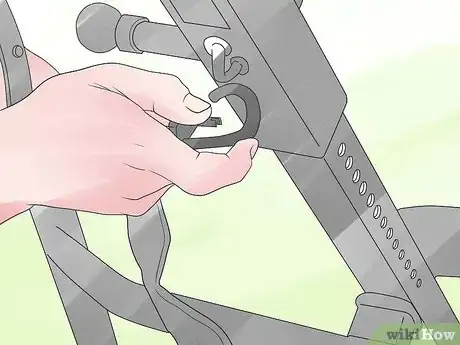
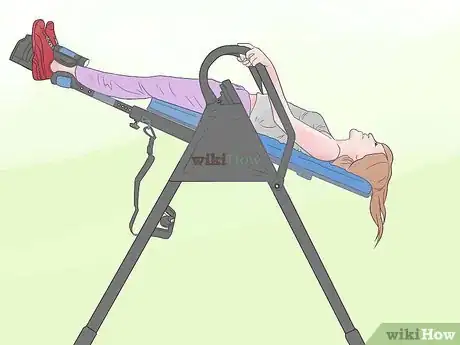


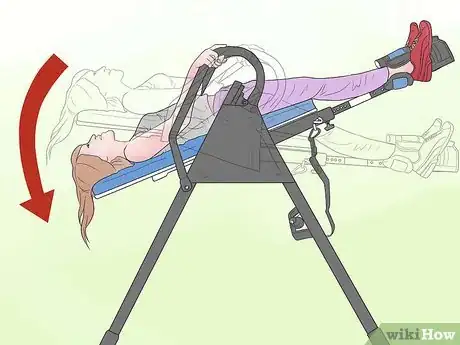
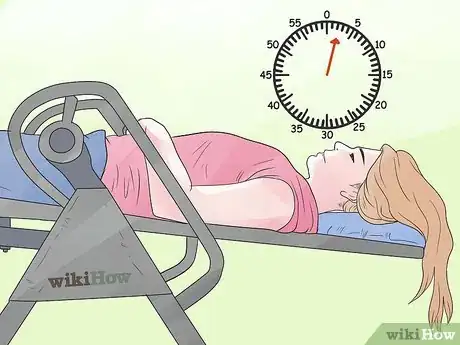
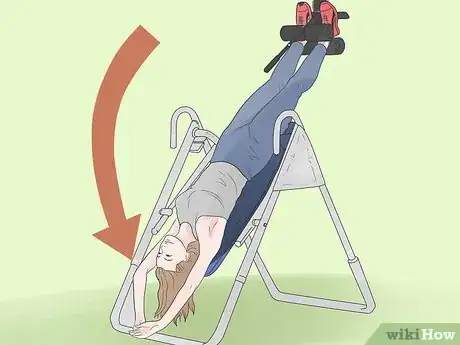

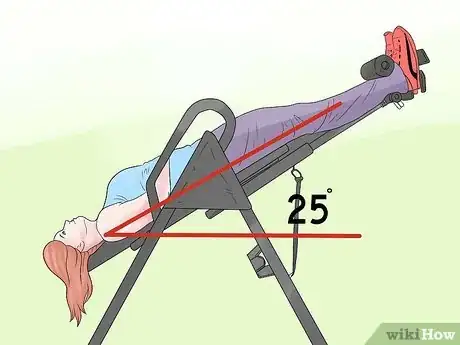

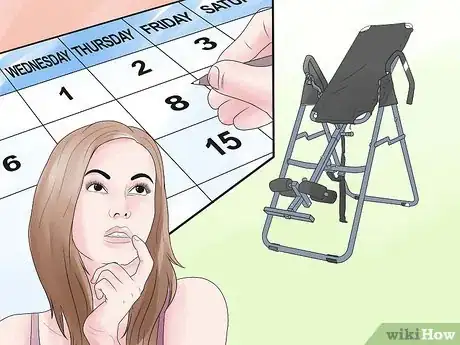
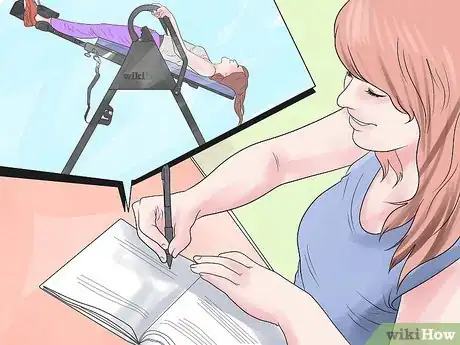





























































Medical Disclaimer
The content of this article is not intended to be a substitute for professional medical advice, examination, diagnosis, or treatment. You should always contact your doctor or other qualified healthcare professional before starting, changing, or stopping any kind of health treatment.
Read More...